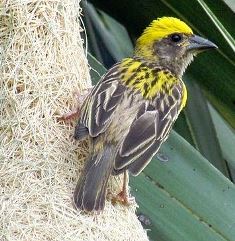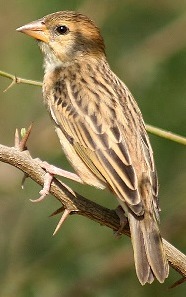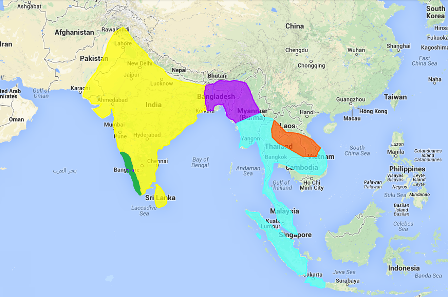Weaver Wednesday [97]: Baya Weaver 2014-04-23 (508)
 Weaver Wednesday
Weaver Wednesday


The Baya Weaver Ploceus philippinus is the most common and widespread weaver in Asia. The Baya Weaver breeding male has a bright yellow crown, dark brown mask, blackish bill, the upper parts are dark brown streaked with yellow, with a yellow breast and buff belly. Non-breeding males and females are dull coloured, resembling House Sparrows.
The Baya Weaver occurs in eastern Pakistan to Vietnam and western Indonesia (see map below, based on Handbook of the Birds of the World, Vol. 15).
Several subspecies of the Baya Weaver are recognised:

P. p. philippinus occurs on the Indus floodplain in Pakistan, most of India, southern Nepal and Sri Lanka (see yellow on map).
P. p. travancoreensis, occurs in SW India from Goa to Travancore (see green on map). The male is darker above and the breast is darker yellow than in the nominate.
P. p. burmanicus occurs in India (West Bengal, Assam), Bhutan, Bangladesh and Myanmar (see purple on map). It is larger than the nominate, the male has a paler face and throat, and buff breast with darker mottling.
P. p. angelorum occurs in Thailand and Laos (see brown on map). This subspecies has a buff breast and black streaking on the upperparts.
P. p. infortunatus occurs in Myanmar to Vietnam, and south to Java and Bali (see light blue on map). This subspecies is more rufous on the upperparts, breast and flanks than in the other races.

The Baya Weaver inhabits grassland, scrub with scattered trees, mangroves and cultivated areas. It is generally found in open country near water.
The Baya Weaver feeds on seeds, including those of grass, rice, wheat, maize, sorghum, millet and sunflowers. Insects include grasshoppers, flies, termites, beetles, caterpillars and butterflies. It also feeds on nectar, spiders, small snails, and rice frogs. Rice is often the most important food item. The Baya Weaver occupies midday roosts near the feeding grounds.
The Baya Weaver is polygynous, with 3-5 females per male. It is usually colonial, with up to 60 nests in a single tree and more than 200 in some colonies, but solitary nests may be found. It sometimes breeds in mixed colonies with other weavers.

The nest is retort-shaped, and usually with a long entrance tunnel. It is woven by the male from strips of palm, grass or rice-plant leaves. The male builds a ring and then completes the roof, so that the nest resembles a helmet with a chinstrap. Blobs of mud are added to the nest, most probably for reinforcement. The nest is only completed if a female accepts it. The entrance tunnel is built last, often 40-65 cm or more in length. The nest is placed 2-30 m above the ground or water. More than 35 plant species have been used, but Acacias are often favoured. Often colonies are close to human habitation, and are also found on telephone lines. Nests are sometimes associated with wasps or aggressive ants.

The eggs, most commonly clutch of 3, are white. The female incubates and feeds the chicks, although some males help feed in later stages. Nest predators include snakes, crows, and probably monkeys. Nest destruction by humans is probably the most important source of loss. Old nests are used by a varity of birds and animals, including Scaly-breasted Munia Lonchura punctulata, Indian Silverbill Euodice malabarica, long-tailed tree mouse Vandeleuria oleracea, and nests abandoned at the helmet stage may be used as roost sites by painted bats Kerivoula picta.
There are ten PHOWN records for the Baya Weaver (see PHOWN summary), but many more are needed of this common species. Submit any weaver nest records to PHOWN (PHOtos of Weaver Nests) via the Virtual Museum upload site.
PHOWN summary
Previous Wedn: Gola Malimbe
Full weaver species list
|


 Weaver Watch
Weaver Watch


